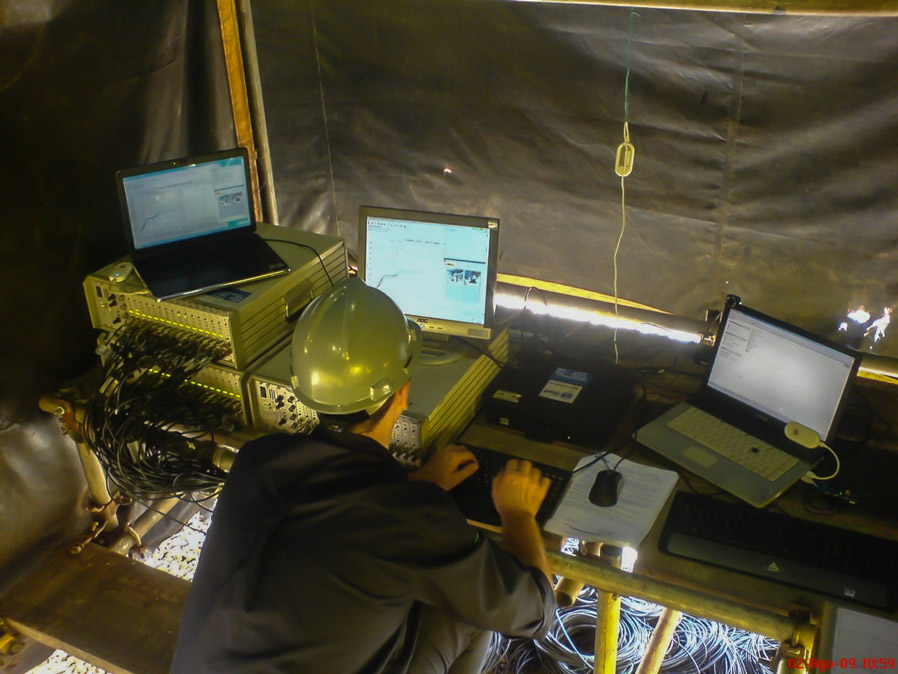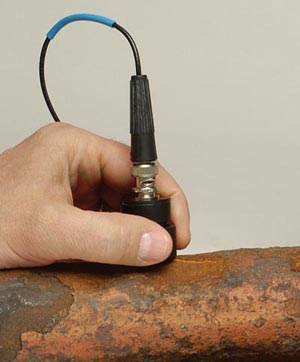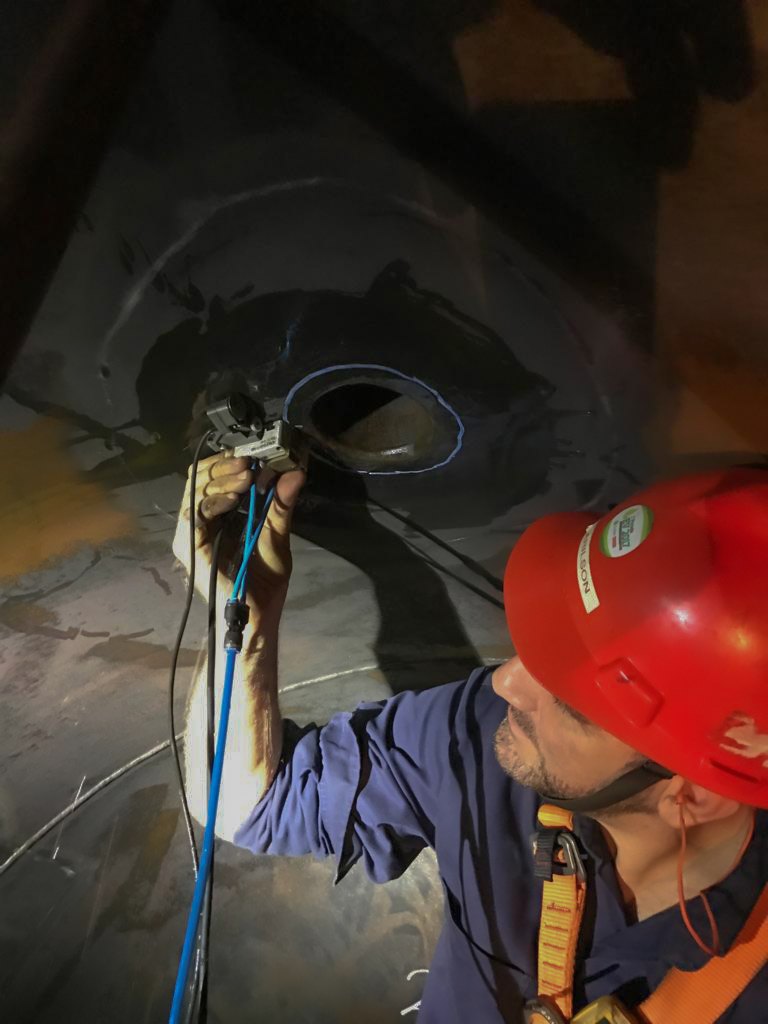NDTs
The company continually invests in technology, including purchasing updated devices, probes, standards and accessories.
We continually develop and incorporate techniques from different non-destructive testing methods, from conventional ones to highly specialized applications.
We continually develop and incorporate techniques from different non-destructive testing methods, from conventional ones to highly specialized applications.
NAVIGATE THROUGH THE MENUS BELOW
TO DISCOVER EACH OF OUR END SERVICES:
Menu
In our facilities, we study and develop applications of acoustic, ultrasound and electromagnetic emission methods, which include the development of procedures and training for field technicians, carried out by our own level II and III professionals, qualified by the SNQC, ASNT/ACCP systems and BINDT/PCN.
ACOUSTIC EMISSION METHOD
We carry out acoustic emission inspections on pressure vessels, boilers, pipes, metal structures, storage tanks, GRP equipment, during pressure tests, in-operation monitoring and continuous monitoring.


ELECTROMAGNETIC METHOD
The electromagnetic method offers a wide range of applications, including crack detection and sizing, thickness measurement, electrical conductivity measurements and inspection of pipes installed in equipment made from any electrically conductive materials.
These techniques advantageously replace traditional examination techniques using penetrating liquid and magnetic particles, mainly due to the possibility of inspecting painted surfaces, with little or no need for surface preparation, inspection of difficult-to-access regions, and has high productivity.
The measurement of small thicknesses of non-ferromagnetic materials with different geometries also stands out. An example is measuring the thickness of expansion joints.
For inspection of tubes installed in heat exchangers, we use special internal probes and multiple frequencies.
Remote field inspection (RFT) and Magnetic Flux Leakage (MFL) techniques have a wide range of applications, including bottom inspection of tanks, pipes and especially tubes installed in exchangers heat and boilers.
These techniques advantageously replace traditional examination techniques using penetrating liquid and magnetic particles, mainly due to the possibility of inspecting painted surfaces, with little or no need for surface preparation, inspection of difficult-to-access regions, and has high productivity.
The measurement of small thicknesses of non-ferromagnetic materials with different geometries also stands out. An example is measuring the thickness of expansion joints.
For inspection of tubes installed in heat exchangers, we use special internal probes and multiple frequencies.
Remote field inspection (RFT) and Magnetic Flux Leakage (MFL) techniques have a wide range of applications, including bottom inspection of tanks, pipes and especially tubes installed in exchangers heat and boilers.
ULTRASONIC METHOD
We perform cold and hot thickness measurements with different types of transducers, from miniaturized to large diameter, operating at different frequencies and EMAT heads.
Measuring the thickness of internal magnetite layers in super heater tubes allows the estimation of their skin temperature, which is used in creep residual life calculations.
For detection and sizing of discontinuities, we apply techniques ranging from conventional to more sophisticated ones, such as TOFD and Phased Array.
Among the applications of the immersion technique, the inspection of heat exchanger tubes and boilers by IRIS (Internal Rotary Inspection System) stands out.
The A/B-Scan and C-Scan techniques with normal heads are applied to map areas with thickness loss.
Measuring the thickness of internal magnetite layers in super heater tubes allows the estimation of their skin temperature, which is used in creep residual life calculations.
For detection and sizing of discontinuities, we apply techniques ranging from conventional to more sophisticated ones, such as TOFD and Phased Array.
Among the applications of the immersion technique, the inspection of heat exchanger tubes and boilers by IRIS (Internal Rotary Inspection System) stands out.
The A/B-Scan and C-Scan techniques with normal heads are applied to map areas with thickness loss.

ACOUSTIC EMISSION METHOD

We carry out acoustic emission inspections on pressure vessels, boilers, pipes, metal structures, storage tanks, GRP equipment, during pressure tests, in-operation monitoring and continuous monitoring.
ELECTROMAGNETIC METHOD

The electromagnetic method offers a wide range of applications, including crack detection and sizing, thickness measurement, electrical conductivity measurements and inspection of pipes installed in equipment made from any electrically conductive materials.
These techniques advantageously replace traditional examination techniques using penetrating liquid and magnetic particles, mainly due to the possibility of inspecting painted surfaces, with little or no need for surface preparation, inspection of difficult-to-access regions, and has high productivity.
The measurement of small thicknesses of non-ferromagnetic materials with different geometries also stands out. An example is measuring the thickness of expansion joints.
For inspection of tubes installed in heat exchangers, we use special internal probes and multiple frequencies.
Remote field inspection (RFT) and Magnetic Flux Leakage (MFL) techniques have a wide range of applications, including bottom inspection of tanks, pipes and especially tubes installed in exchangers heat and boilers.
These techniques advantageously replace traditional examination techniques using penetrating liquid and magnetic particles, mainly due to the possibility of inspecting painted surfaces, with little or no need for surface preparation, inspection of difficult-to-access regions, and has high productivity.
The measurement of small thicknesses of non-ferromagnetic materials with different geometries also stands out. An example is measuring the thickness of expansion joints.
For inspection of tubes installed in heat exchangers, we use special internal probes and multiple frequencies.
Remote field inspection (RFT) and Magnetic Flux Leakage (MFL) techniques have a wide range of applications, including bottom inspection of tanks, pipes and especially tubes installed in exchangers heat and boilers.
ULTRASONIC METHOD

We perform cold and hot thickness measurements with different types of transducers, from miniaturized to large diameter, operating at different frequencies and EMAT heads.
Measuring the thickness of internal magnetite layers in super heater tubes allows the estimation of their skin temperature, which is used in creep residual life calculations.
For detection and sizing of discontinuities, we apply techniques ranging from conventional to more sophisticated ones, such as TOFD and Phased Array.
Among the applications of the immersion technique, the inspection of heat exchanger tubes and boilers by IRIS (Internal Rotary Inspection System) stands out.
The A/B-Scan and C-Scan techniques with normal heads are applied to map areas with thickness loss.
Measuring the thickness of internal magnetite layers in super heater tubes allows the estimation of their skin temperature, which is used in creep residual life calculations.
For detection and sizing of discontinuities, we apply techniques ranging from conventional to more sophisticated ones, such as TOFD and Phased Array.
Among the applications of the immersion technique, the inspection of heat exchanger tubes and boilers by IRIS (Internal Rotary Inspection System) stands out.
The A/B-Scan and C-Scan techniques with normal heads are applied to map areas with thickness loss.
